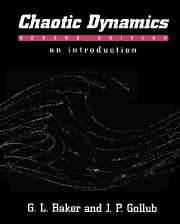Book contents
- Frontmatter
- Contents
- Preface
- Acknowledgments
- CHAPTER ONE Introduction
- CHAPTER TWO Some helpful tools
- CHAPTER THREE Visualization of the pendulum's dynamics
- CHAPTER FOUR Toward an understanding of chaos
- CHAPTER FIVE The characterization of chaotic attractors
- CHAPTER SIX Experimental characterization, prediction, and modification of chaotic states
- CHAPTER SEVEN Chaos broadly applied
- Further reading
- Appendix A Numerical integration – Runge–Kutta method
- Appendix B Computer program listings
- Appendix C Solutions to selected problems
- References
- Index
- Diskette order information
CHAPTER TWO - Some helpful tools
Published online by Cambridge University Press: 05 June 2012
- Frontmatter
- Contents
- Preface
- Acknowledgments
- CHAPTER ONE Introduction
- CHAPTER TWO Some helpful tools
- CHAPTER THREE Visualization of the pendulum's dynamics
- CHAPTER FOUR Toward an understanding of chaos
- CHAPTER FIVE The characterization of chaotic attractors
- CHAPTER SIX Experimental characterization, prediction, and modification of chaotic states
- CHAPTER SEVEN Chaos broadly applied
- Further reading
- Appendix A Numerical integration – Runge–Kutta method
- Appendix B Computer program listings
- Appendix C Solutions to selected problems
- References
- Index
- Diskette order information
Summary
In this chapter we discuss three mathematical constructs that are generally useful in the study of dynamical systems: phase space, the Poincaré section, and power spectra. Phase space is the mathematical space of the dynamical variables of a system. The Poincaré section is a ‘snapshot’ of the motion in the phase space, taken at regular time intervals. The power spectrum is computed using Fourier analysis to display the frequency composition of the time variation of the dynamical variables.
Phase space
The phase space of a dynamical system is a mathematical space with orthogonal coordinate directions representing each of the variables needed to specify the instantaneous state of the system. For example, the state of a particle moving in one dimension is specified by its position (x) and velocity (v); hence its phase space is a plane. On the other hand, a particle moving in three dimensions would have a six-dimensional phase space with three position and three velocity directions. A phase space may be constructed in several different ways. For example, momenta can be used instead of velocities.
Let us focus the discussion on the pendulum and begin with the familiar simple pendulum in the small amplitude approximation where the restoring term, sinθ, is taken as θ. (Recall that the equations are written in dimensionless form for simplicity, with time measured in units of the inverse of the natural frequency.)
- Type
- Chapter
- Information
- Chaotic DynamicsAn Introduction, pp. 7 - 38Publisher: Cambridge University PressPrint publication year: 1996
- 2
- Cited by



